Thank goodness for the Midwest LSA Expo. As the one and only airshow (other than some small local gatherings) since Copperstate/Buckeye back in February, Midwest 2020 was a breath of fresh air… literally for those of us who attended (quite a few did).
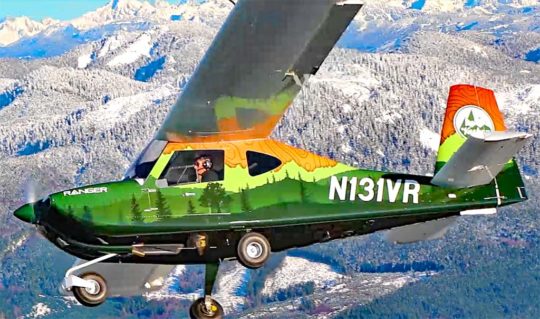 From my view — and to some extent for all the readers of this website — the single most valuable aspect of Midwest LSA Expo is the great ease with which one can take one or more demo flights. For me in particular, this is a unmatched opportunity to go aloft in an aircraft so I can write about it.
From my view — and to some extent for all the readers of this website — the single most valuable aspect of Midwest LSA Expo is the great ease with which one can take one or more demo flights. For me in particular, this is a unmatched opportunity to go aloft in an aircraft so I can write about it.
Regretfully, my video partner Videoman Dave was not allowed by U.S. authorities to enter the country from Canada, so we did not get to capture Video Pilot Reports where several aircraft get fitted with Dave’s collection of seven Garmin VIRB cameras. Instead, my flight experience in Flight Design’s F2 and Vashon’s Ranger lack some of the wonderful video Dave assembles into the popular video on his YouTube channel.
The good news: I can still write about them. So, here goes…
New, and Moving Up Smartly
We have fresh LSA and SP kit aircraft market statistics and after some research, I will report more fully on the 3Q20 numbers. However, we know one thing already: it appears Vashon’s Ranger will be the best seller among Special, fully-built Light-Sport Aircraft for this unusual year. Covid complications be damned, Vashon is putting out about two aircraft a month and it appears momentum is building.
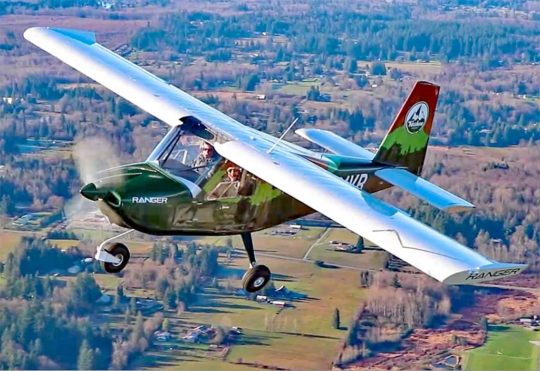
He made most of his fortune from a semiconductor company once headquartered in the same building in Woodinville, Washington that has been reconfigured into Vashon’s home base. John grew up flying light airplanes and after doing well in semiconductors, he turned his attention to bringing modern, affordable avionics into aviation. He started in LSA where onerous certification was not required. Since the successful D-10 EFIS in 2003 Dynon Avionics has greatly expanded their line and has more recently offered products for conventionally-certified aircraft.
Today, more than 20,000 aircraft have Dynon avionics gear in their panels.
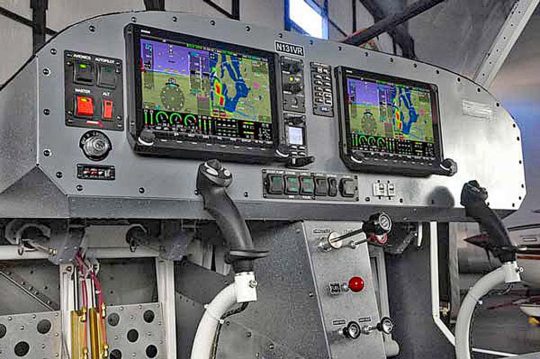
Vashon produces structural components and puts fuselages and wings together in Woodinville but these sub-assemblies are then transported to a hangar at the Paine Field Airport (KPAE) in Everett. This is the same airfield where final assembly takes place at Boeing’s massive facility.
Flying Ranger
Ranger’s doors swing open wide. Its cantilevered wings offer no lift strut obstruction to entry. The cabin is spacious like most LSA. Put it all together and this large, squarish cockpit can accommodate some good-sized occupants. To accommodate pilots of different height, Ranger’s rudders adjust, but this must be done before takeoff as it employs a pin-lock system (nearby photo).

With half tanks and no baggage, demo pilot Kurt Robertson and I probably flew below the gross weight limit. We could have flown for better than three hours.
Vashon chose the 100 horsepower Continental O-200 engine that Americans know so well. It burns 5.5 gallons an hour in economy cruise, which is where most pilot may fly unless going cross country. Topped off full, a solo pilot could fly for better than five hours. In our flight, I saw speeds above 110 knots at a low altitude of 2,500-3,500 feet above ground. At cross country altitude, it was clear, Ranger will run close to the LSA speed limit of 120 knots so a lone pilot could travel as much as 600 nautical miles non-stop.
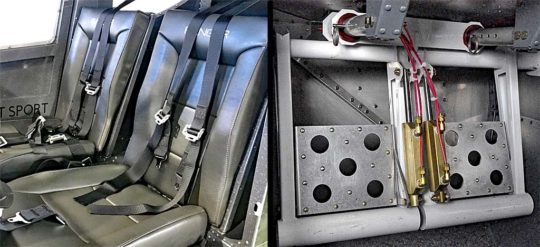
Takeoff was simple and straightforward. After liftoff, Ranger’s rate of climb varied between 600-800 fpm to 3,500 where we practiced some stalls. Fuel burn during best rate of climb appears to be north of seven gallons an hour, about the same as a Rotax 912iS. Kurt reported he routinely sees 118 knots at altitude and burns 6-6.5 gallons an hour at this higher cruise speed.
Flaps are electrically actuated with a button — one push for 20 degrees; another push deploys flaps to 40 degrees. We used one notch for takeoff and either one, both, or none for landing.
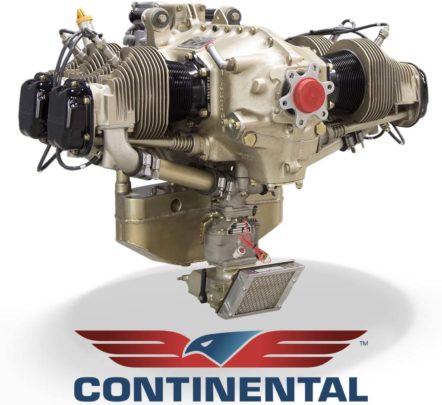
In flight, Ranger is very well behaved, no wonder as this model shares some designer heritage with the Van’s series that are highly revered for great flight qualities. You need only minimal rudder entering and exiting turns. Joystick pressures are fingertip-light (photo).
In stalls, the LSA can be called docile with no evil bones I could uncover despite fairly steep stall entries. Recovering from a full-stick-aft stall showed no steep break or wing drop. Ranger exhibits very modest pitch change when flaps are deployed up or down.
In slow flight or on approach to landing, Ranger was very stable and my landing was quite good even for a first-ever effort. At Kurt’s advice I held 65 knots down low, then slowing slightly.
Construction & Interior
Ranger is built with all-metal construction although the main landing gear is a composite structure. Its cantilevered high wing with no lift-strut combines with a broad windscreen to offer an expansive view.
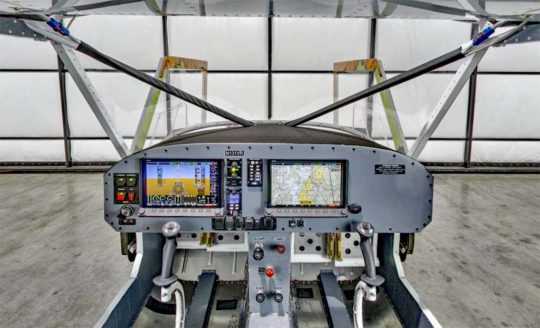
The large space aft of the seats can hold up to 100 pounds. While most loading won’t tolerate that much baggage weight, the space is large enough for sleeping bags, tents, fishing poles, and other (lighter weight) outdoor gear.
Buy All-American? — The western U.S. company boasts that its Special LSA is fully American. “Ranger R7 is designed, engineered, tested, and manufactured at the Vashon Aircraft factory headquarters near Seattle, Washington, and is assembled at its Paine Field assembly and delivery center (on the same airfield as Boeing’s wide body airliner factory),” said Vashon. Avionics are made by Dynon Avionics in Woodinville, Washington and the powerplant is built by Continental Aerospace Technology in Mobile, Alabama.
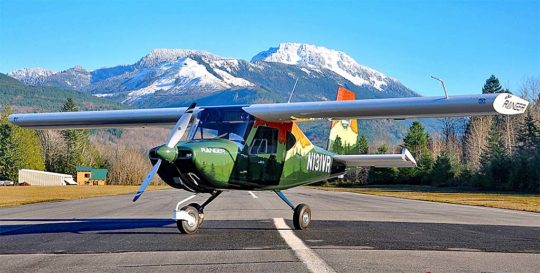
Exterior Treatment — The “Founders Design” with the Washington state scene (photos) adds $9,500 to the base price. A version with the back half looking similar and the front fuselage in white is only $2,500. A treatment on just the top half of the vertical stabilizer is included in the price.
If six figures aren’t in your checkbook the company observed, “Vashon Aircraft is proud to collaborate with AOPA Finance to offer our customers competitive financing options for their Ranger purchase.”
Check all Vashon Ranger’s specifications on this dedicated page.


Hi Dan — I know this is an older article, but curious. Which airplane was more fun to fly…the Vashon Ranger or the Aerotrek A240? I understand all the engine/avionics/etc difference. Just curious on flying fun. Thanks!
Personally, I enjoyed Aerotrek more but that is significantly because I like an aircraft with light-touch handling and it qualifies. Contrarily, for those who want an all-metal exterior, it’s Ranger.
At least in the Vashon, you will be camouflaged and hidden in the trees when you go down. What? You would want to be hidden in the trees, wouldn’t you? Oh, depends upon what country you’re flying in. I see.
So, you ran out of gas which you can’t even buy where you are.
That dirty kerosene generator that’s in the last village could charge your batteries. Oh yeah, this is mission work that has nothing to do with prime time. This is BUSH country. Oh, you say you carry a small generator with a smidgen of that dirty diesel just for charging the batteries. OOhhh! it’s an ‘ELECTRIC’ bush plane. Well, what were you thinking?
I followed the progress of Vashon the last few years and ordered one at Sun n’ Fun 2021. This airplane checks off many boxes for me. I visited the factory last month and was generally pleased with what I saw. Their imminent move to bring production and final assembly under one roof will streamline the work flow. I look forward to receiving mine and was wondering why this airplane doesn’t show up in this site’s PlaneFinder 2.0?
I have been trying to replicate your challenge, but I cannot. Vashon’s Ranger R7 is definitely in the PlaneFinder 2.0 list. I was able to see it after checking the following answers = Aircraft Type: Standard > Wing Position: High Wing > Construction: Metal > Country of Origin: U.S.
Of course, you could click several other other attributes, but those four definitely show Vashon appears in the list. Please try again. And just to be extra helpful, here is a link to all Ranger content.
Thank you Dan. My mistake as I thought the Plane Finder was more like a table of various specs, etc., as opposed to linking to airplane articles specific to a search. I do see all the reporting and I appreciate the reviews.
I have owned a Cessna 150 L model for 25 years and want a new plane with either a Continental or Lycoming engine. New as in brand new. Unfortunately I have been priced out of the market. I wanted to see how this airplane faired in the marketplace and am satisfied it will make it. I’ll be contacting them. My partner is an A&P and loves, loves, loves the O-200. I do, too.
I’ve owned N135VR since the fall of 2018. Sold my Cirrus as I head to retirement. Keep the Vashon at the local private strip five minutes from my house. Great flying airplane! Even better customer support. Love this new bird and happy with 1/3 the fuel burn and half the speed of the Cirrus. Get your deposit in. Can’t miss with this airplane. 1/2 tanks and some duffel bags in the back bd my wife and I can fly anywhere in New England. One fuel stop takes us down to visit friends in Virginia, no problem.
Having worked on many Rotax 912s, one must consider items like every 5 years new rubber hoses, $3,000 with labor etc., requiring engine removal, carb balancing every year, slip clutch check, plus gear box and oil tank flushing if using 100 LL., which is garbage to put in a Rotax designed for non-ethanol 93 car gas. Time out TBO is 15 years. Other than these items Rotax is a great engine.
I prefer the Continental engine, because these items are a non-issue and has a much a lower parts count and is direct drive. Mechanics all over the world are happy to work on Continental or Lycoming engines. The same can not be said for Rotax. Sorry, Rotax you are great in snowmobiles.
I am waiting for the LSA rules to change before buying. Meanwhile I am content to rent.
I’m in north Florida and I can’t find 93 octane non-ethanol car gas anywhere. The highest seems to 89. Where did you find it?
A company called “GoGas” sells Hi-test Ethanol free all over my area of North Carolina. It can be stored quite a long time. Also great for generators, mowers and so on.
By the way it is not difficult to remove ethanol yourself. Check out YouTube.
Oliver and Russell: The following articles delve into E0 or no-ethanol fuel; the first had a link to a website that identifies where such fuel can be found (as many vintage autos, boats,a d recreationL vehicles prefer):
(1) https://www.bydanjohnson.com/lsa-fans-comment-on-ethanol-in-mogas/ ▪️ Here is the link to that website: https://www.pure-gas.org/
(2) https://www.bydanjohnson.com/future-shock-ethanol-mogas-avgas/
I’m curious about why the Vashon Ranger seems to be selling well, while the Cesna Skycatcher was a bit of a flop and stopped production a few years ago. Yet, the specifications of each plane are virtually identical with the most notable exception being that the Ranger’s empty weight is 875 pounds, 45 pounds heavier than Skycatcher’s empty weight of 830 pounds. It’s difficult to judge by pricing, which doesn’t seem to have any glaring difference. I must be missing something.
Flying magazine had a write up on the Cessna about 2 months ago. It went into detail about why it flopped.
Michael: I follow Flying Magazine for much in the general aviation or larger aircraft, but I would urge your caution about their analysis of Light-Sport or smaller. It is simply not their area of expertise and they would tend to look at Skycatcher’s demise from a legacy aircraft builder’s viewpoint. It simply was not the aircraft the LSA market wanted and they made a few strategic design decisions, the last of which was greatly increasing the price.
Would you like to triple your media exposure and get people really interested in the Ranger R7?
I am building an educational Campgrounds in Carmel Valley Ca
We have our own private runway 2700 feet.
I want to create a TV really show based on High School Students and Veterans learning how to fly.
Sean
415-328-8122
Sean: That sounds like a great idea, but please use links in the article to contact Vashon directly. It is not guaranteed they will see this comment. Good luck with your project!
The Continental engine is made in the United States but the Chinese own the company, I do believe.
Larry: You are correct but the engines and company remain fully American. Note that Cirrus, Mooney, and others also have Chinese investors.
Hi Dan, You did a bit of exaggerating when comparing the Continental 0-200 which is a carburetor engine to the Rotax 912iS. The dry weight Continental boasts about is 199 lbs. Where the Rotax 912 or even the 914 carburetor run gas turbo weighs about 167 lbs wet. (fully will nstalled weight). Here are the stats to look at.
Rotax 912 ULS (carburetor) burns 5.7-6.0 gph at 100% 4.5 gph at 75% power.
Rotax 914 turbo 115 hp (carburetor) burns 6.6 gph at 100% power and 5.3 gph at 75%.
Rotax 912iS fuel injected 100 hp engine is best of all. It burns only 4.5 gph at 100% power and 3.6-3.8 gph at 75%.
With comparing apples to apples, either consider either one of the carburetor models as the fuel consumption is higher but still lower than the Continental in both weight and gas consumption.
With low weight and good power and proven quality, nothing beats the Rotax 912iS engine! It only uses 1.7 gph at 50% power. Amazing!
One more story comment. The Ikarus C42 was a training aircraft for my light sport ticket. On my solo day a couple of airline pilots rented it for an hour. When they came in the land it, they made a hard landing and bent the nose wheel and chipped the prop. Needless to say I was madder than a Murder Hornet because I had to drive 70 miles back home without my solo flight. I got that flight the next weekend and what a joy it was.
That aircraft looks comparable to the Comos Ikarus C42 with the Rotax 912 100 hp. I have about 65 hours flying. Looks like a really cool airplane with a good price.
Ken: I don’t believe C42 and Ranger are particularly similar. One is all metal with stressed skin, while C42 (Germany’s best selling European-style ultralight) is aluminum tube with sewn Dacron coverings. Both are good but hardly “comparable.”